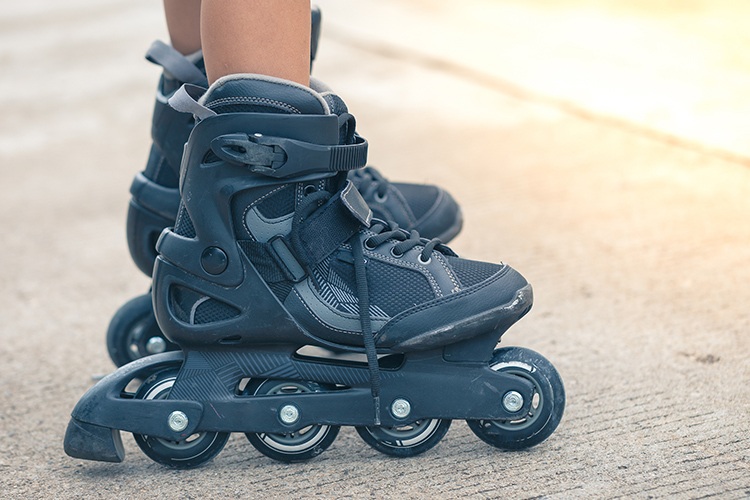Dozens of companies make inline skates, but Rollerblade is the brand that made the sport a global phenomenon. With more than 200 patents and over 100 trademarks, the company is a major player in the inline skate industry.
Rollerblade created the first inline skate with a working brake and a flexible boot. The brand has become so popular that many people think “Rollerblade” is the generic term for inline skating. That’s incorrect, however. Rollerblade is a registered trademark that belongs to the Nordica sports company.

From Ice To Land
Ice skating has been a popular pastime since the 1700s, but nobody thought skating on land was a real possibility. In 1735, a French inventor named John Joseph Merlin created a pair of skates with small metal wheels. He designed them as a publicity stunt, however, and not for regular use.
Earth Skates
In 1789, another French inventor tinkered around with Merlin’s original design. Lodewiik Van Lede created a skate he called an “earth skate.” This was essentially a flat wooden plate that rested on a row of three wheels.
This basic design remained the standard for roller skates for more than 100 years. The number of wheels changed from three to six. In every design, the lack of a brake was a major flaw. The skates didn’t catch on with people because there was no safe way to stop once you started rolling.
Revolutionary Design
In 1863, James Plimpton invented skates with the first major design upgrade. The Massachusetts inventor’s design, which he called “quad skate” or “rocker skate,” was easier to use and much safer than previous designs. It was a skate with two pairs of wheels placed next to each other.
Instead of attaching wheels to a flat plate, Plimpton attached them in a “wagon wheel” style that allowed each wheel to move independently. The design allowed the user to make turns simply by leaning to one side.
First Roller Skating Rinks
Plimpton’s design revolutionized the industry, and quad skates became the industry standard. Plimpton patented his design and opened a factory in New York.
Sales of his skates soared. He used his success to open the country’s first roller skating rinks in New York City and Newport, Rhode Island. In 1863, he founded the New York Roller Skating Association, which was the first professional skating association in the country.
Plimpton’s design remained the standard until the 1900s, when roller skating companies began modifying it to create new versions. In 1910, the Roller Hockey Skate Company was the first to add a leather shoe to the skate.
Skating Goes Global
Ice rinks began opening all over the country and the rest of the world. Doctors in the U.S. and the U.K. recommended roller skating as a healthy form of exercise.
By the 1950s and 1960s, roller skating was a wildly popular pastime. In the 1970s, the sport of roller derby transformed it into a contact sport. It was during this time that two brothers in Minnesota came across an old pair of skates.
Intrigued by an Antique
In 1979, Scott and Brennan Olson were semiprofessional hockey players. One day, they were in a skating store with a display of antique skates. They were intrigued by a pair from 1966 that had a single row of wheels down the middle. Most roller skates still used two rows of skates.
They thought an improved, updated version of the style was just what they were looking for.
Skates for the Off Season
Initially, the Olsons didn’t plan to make a skate for the public. They wanted to make a skate that hockey players could use to practice skating when ice wasn’t available. A single row of wheels was the closest thing to the single, slender blade of an ice skate.
They began by updating the materials and adding a toe brake. After repeated attempts, they finally developed a design that worked.
In 1980, the Olsons trademarked the name Rollerblade and began marketing their skates to hockey players. Rollerblades became an enormous hit among off-season hockey players, Nordic skiers and speed ice skaters, who all used them for training.
Selling the Name
There were some design problems that kept them from catching on with the non-athletic public, however. Braking was difficult, the skates were hard to put on, and the wheels fell off easily. In 1984, the Olsons sold their trademark and company to business owner Bob Naegele, Jr., who had the resources to upgrade the design on a large scale.
Over the next few years, revamped models of the original Rollerblades hit the market. Made from fiberglass, they included better braking technology and secure wheels. The skates were easy to put on and comfortable.
In 1986, the manufacturer began marketing inline skating as a fun activity that anyone could enjoy. Rollerblades became extremely popular, and “Rollerblading” entered everyday language. Other companies rushed to produce their own versions of the popular inline skates.
Rollerblade was later bought by Nordica, an Italian company that makes ski equipment.
Becoming Generic
People still use the term “Rollerblading” to refer to inline skating. The word is not generic, however.
Like other popular brands, Rollerblade has fought the use of its name as a generic term. The company has created promotional campaigns that stress its name and sells branded merchandise to Rollerblading enthusiasts.
In 1993, it filed a patent lawsuit against 33 competing inline skate manufacturers. Seven of the defendants settled with Rollerblade later that year, and the other cases were dismissed.
Read more on common word trademarks.
Stemming the Tide
The lawsuit is part of the company’s efforts to prevent its name from becoming generic. Right now, it is still a registered trademark, and Rollerblade intends to keep it that way.

